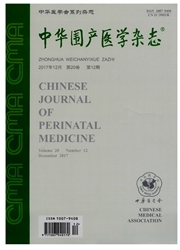

 中文摘要:
中文摘要:
目的分析总结胎儿心脏横纹肌瘤的影像表现及预后情况,提高对本病的认识,探讨更完善的产前诊治模式,以改善患儿的预后。方法回顾性分析2008年1月至2015年11月问在复旦大学附属妇产科医院超声提示胎儿心脏横纹肌瘤的23例病例的一般情况、影像学特征、预后及随访情况。对数据资料采用描述性分析。结果23例孕妇平均诊断孕周为(29.8±4.1)周(22.4~35.7周),其中17例(74%)参加了本院产前诊断中心组织的多学科会诊。23例中,3例(13%)失访,12例(52%)引产终止妊娠,8例(35%)继续妊娠且足月分娩均随访至患儿3周岁。8例中,2例产前行胎儿头颅MRI检查未见异常,随访时心脏横纹肌瘤均已消失,生长及智力发育均正常;1例产前于本院行胎儿头颅MRI检查疑似室管膜下结节性硬化病灶,外院复查MRI提示未见异常,随访时心脏横纹肌瘤已消失,生长发育及智力发育均正常。4例产前未行MRI检查,生后行新生儿头颅MRI提示结节性硬化病灶,随访时患儿均有癫痫发作,生长发育均正常,除1例外,另3例存在不同程度智力发育落后;其中2例心脏横纹肌瘤消失、2例心脏横纹肌瘤无变化。1例既未行胎儿MRI,又未行新生儿MRI,但随访发现心脏横纹肌瘤已消失,生长发育及智力发育均正常。结论心脏横纹肌瘤是否合并结节性硬化对患儿的预后至关重要。产前超声检查辅助胎儿头颅MRI检查,可提高心脏横纹肌瘤合并结节性硬化症的诊断,协助临床决策及预后分析。
 英文摘要:
英文摘要:
Objective To improve the awareness of fetal cardiac rhabdomyomas (CRs) and investigate a better model for prenatal diagnosis and treatment through analyzing imaging findings and prognosis. Methods A retrospective study was conducted on 23 cases of CRs which were diagnosed by ultrasound in Obstetrics and Gynecology Hospital of Fudan University from January 2008 to November 2015. General conditions, imaging features, prognosis and follow up data of the 23 cases were described. Results The average gestational age of the 23 fetuses at diagnosis was (29.8±4.1) (22.4-35.7) weeks. Seventeen out of the 23 gravidas received prenatal multidisciplinary consultation. Among all 23 gravidas, three (13%) were lost to follow-up, 12 (52%) decided to terminate the pregnancy, and the other eight (35%) continued to term pregnancy and their babies were followed up for three years. Of these eight cases, two cases received prenatal brain MRI and no tuberous sclerosis complex (TSC) was detected, no CRs was identified during the follow-up, and their physical and mental developments were both normal. One case was diagnosed with suspected subependymal nodules by prenatal brain MRI in our hospital, but the MRI images was normal when scanned in the other hospital, and follow-up data revealed neither CRs nor abnormal physical and mental developments. Four cases did not received prenatal brain MRI, but the MRI images of neonatal brains indicated TSC, besides, follow-up data showed that seizures were observed, physical developments were all normal, but three of the four cases had mental retardation; CRs disappeared in only two of the four cases. One case had neither prenatal nor neonatal MRI, but follow-up data showed that CRs had disappeared and physical and mental developments were both normal. Conclusions Prenatal diagnosis of fetal tuberous sclerosis is crucial to the prognosis of CRs. Prenatal ultrasonography in combination with cranial MRI improves the accuracy of prenatal diagnosis of CRs complicated with TSC
 同期刊论文项目
同期刊论文项目
 同项目期刊论文
同项目期刊论文
 期刊信息
期刊信息
